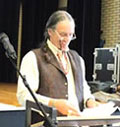 |
|||||||||||||||||||||||
Audio Interviews Don't miss another Issue! |
MAY 2016
Hi folks, It has been a long winter. Spring has finally sprung and I have experienced sunshine for 7 consecutive days. This is a large feat as there has not been that many consecutive days of sunshine all winter. Over the winter, new information came out about the longevity of organizations. It has declined from 50+ years to 31.6 years. Seems odd to think about life expectancy of organizations until we realize that the lack of thinking about it is why quarterly performance rules and long term planning ends at 12 months. As coaches and leaders, I suggest thinking about how long an organization should live and why there are no vision statements focusing on the next 20-30 or 50 years. At a minimum, it will be an interesting reflection...one I hope begins a paradigm shift to a healthier mode of doing business. Assuming long life is considered a virtue especially for future generations. The primary focus of this issue is competition among leaders. It is a common coaching focus on how to transform hyper-competitive behaviors into strong leadership. A few details on upcoming events. I will be in Montana for a retreat on visioning sponsored by SOL in September. We will combine the traits of the Fifth Discipline with the panoramic views of the Black Tail Ranch in Wolf Creek Montana. Also, in October, we will be doing the week long coaching intensive. Respectfully, 
Herb Stevenson, CEO/President LeadershipThe Impact of Internal CompetitionHerb Stevenson In the most basic terms, leadership is relational. It requires a group or team of people that are willing to follow. The relationship is based on trust built over time from observed behavior that indicates:
See CCG Newsletter February 2015 The lack of any of these variables will result in a reduced commitment to follow. Work will get done through compliance instead of engagement. Leadership QualitiesBesides the ongoing observation of trust defining behaviors, leadership, often, has been defined by the qualities that a leader must possess. These have generally been described with respect to team development and task-oriented behaviors. Different times and different situations require different leadership styles; however, certain qualities endure. (Goleman, 2000)These qualities are generally incorporated in the four basic factors (Rittelmeyer 1991):
In more dynamic terms, a successful leader must be able to enter into noncompetitive relationships with individuals who work with him or her and to enjoy vicarious success by providing optimal situations for others to flourish. In other words, the leader must lead, not win. CompetitivenessA dynamic that has surfaced in my coaching practice is a transference of competing while in lower ranks to positions of authority. By the very nature of most hierarchical organizations, competing shows up in the amount of work that gets done and by whose ideas are accepted toward problem solving . Competition can increase through building sideline support prior to meetings and/or sabotaging the perceived competitors by withholding information, taking credit for work done by others, and silencing contrary (competitive) voices. In each case, the competitiveness of the individual undermines the success of the team or organization. Moreover, it indicates behavior that is not trustworthy nor reflective of effective leadership qualities. Some leaders will disagree with the prior paragraph, because they believe that competitiveness follows the survival of the fittest thinking. They encourage the competition and feebly contain it by not setting boundaries around what is healthy versus unhealthy competition. Unfortunately, in today’s environment, a “dog-eat-dog” belief misses the point for surviving in today’s capitalistic environment. Such internal competition must include a set of ground rules that reminds everyone that we’re on the same team and undermining others to “win” serves no one but that individual. This becomes more important when we realize that between 1970 and 2010, the life expectancy of corporations has declined from 50+ years to 31.6 years old. (Reeves, et. al., 2016). Furthermore, the rising generation of Millennials do not necessarily compete with fellow employees; rather, they seek employment where team competition towards a greater good exists. Military or sports metaphors do not internally drive this generation. They are driven by “how to save or improve the world” and "why should I join you." Finding the common purpose (Kurtzman, 2010) is going to be imperative. (See also, Simon Sinek, "Start with Why"). As coaches and leaders, the question becomes how to harness competition into a higher standard of performing within the organization and therefore within any industry. I believe coaches and leaders are going to be encouraged to relinquish the dog-eat-dog form of competition and replace it with more purposeful driving forces that motivate people to engage each other even in competitive situations. ClosingIt’s interesting that client’s refer to being part of a team while behaving like they want to destroy each other through power plays and gamesmanship. As coaches, we have our hands full as we try to change the driving paradigm of the leaders. As leaders, based on survival trends, unless there is a complete paradigm shift toward creating healthy competition, the best you can hope for is to cash out before your organization no longer exists. Unfortunately, some will believe that doing so would be ”winning”
Scoring:Answering ‘true’ to questions 1, 2, 4, 6, 7, 9 and 10 reveals a tendency toward hypercompetitiveness. Those who answer ‘true’ only to 3, 5 and 8 tend to have a healthy attitude toward competition. Source: Richard Ryckman et al., Journal of Personality Assessment. ReferencesCherniss, Cary & Daniel Goleman (2001) The Emotionally Intelligent Workplace, 42. Goleman, Daniel (2000) Leadership that Gets Results, Harvard Business Review, 82-83. Kurtzman, Joel. (2010) Common Purpose: How Great Leaders Get Organizations to Achieve the Extraordinary. Jossey Bass. Reeves, Martin. Simon Levin, & Daichi Rewell, (2016) The Biology of Corporate Survival: Natural ecosystems hold surprising lessons for business. January–February Harvard Business Review Rittelmeyer LF (1990). Leadership in an academic department of psychiatry. Academic Psychiatry, 14, 57-64. Sinek,Simon. (2011) Start with Why. Inspiring Emerging Vision:
|
||||||||||||||||||||||


 Executive & Life Coaching: A Journey into Advanced Skill Building is a “coming- home” experience for those seeking to build upon their existing coaching skills. It is an indepth experience steeped in personal growth through self awareness and professional development through a refinement of your coaching/consulting skills. Though based in gestalt/ontological theory, the core concepts will be “use of self”, “presence” and “paradoxical theory of change” which permeate many coaching philosophies. In addition, we will include a form of peer coaching that is gaining momentum as a leader development process as well as a team development process.
Executive & Life Coaching: A Journey into Advanced Skill Building is a “coming- home” experience for those seeking to build upon their existing coaching skills. It is an indepth experience steeped in personal growth through self awareness and professional development through a refinement of your coaching/consulting skills. Though based in gestalt/ontological theory, the core concepts will be “use of self”, “presence” and “paradoxical theory of change” which permeate many coaching philosophies. In addition, we will include a form of peer coaching that is gaining momentum as a leader development process as well as a team development process.